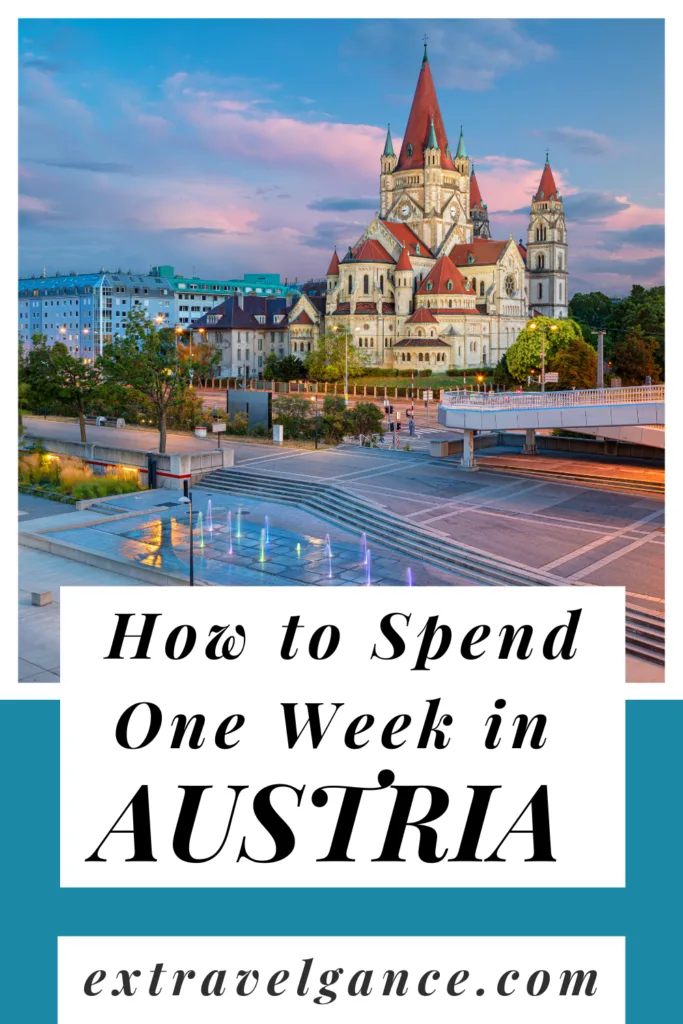
If you love music, history, films, natural scenery, or architecture, then you should spend one week in the gorgeous country of Austria! The country is filled with amazing sites and things to do. Here’s an itinerary to help you plan a wonderful week.
Note: We may earn a small commission from the affiliate links in this post.
One Week Itinerary
If you have one week to spend in Austria, here’s the itinerary I recommend:
Sunday
Plan to depart from the U.S. on Saturday for a Sunday arrival in Vienna, Austria. Most flights originating in the U.S. will arrive in Vienna in the morning giving you a full day to spend touring. I know it may be tempting to request an early check in to your hotel and take a nap. But don’t do it! You need to stay up ALL day so that you can beat the inevitable jet lag you will feel. Get outside and start touring!
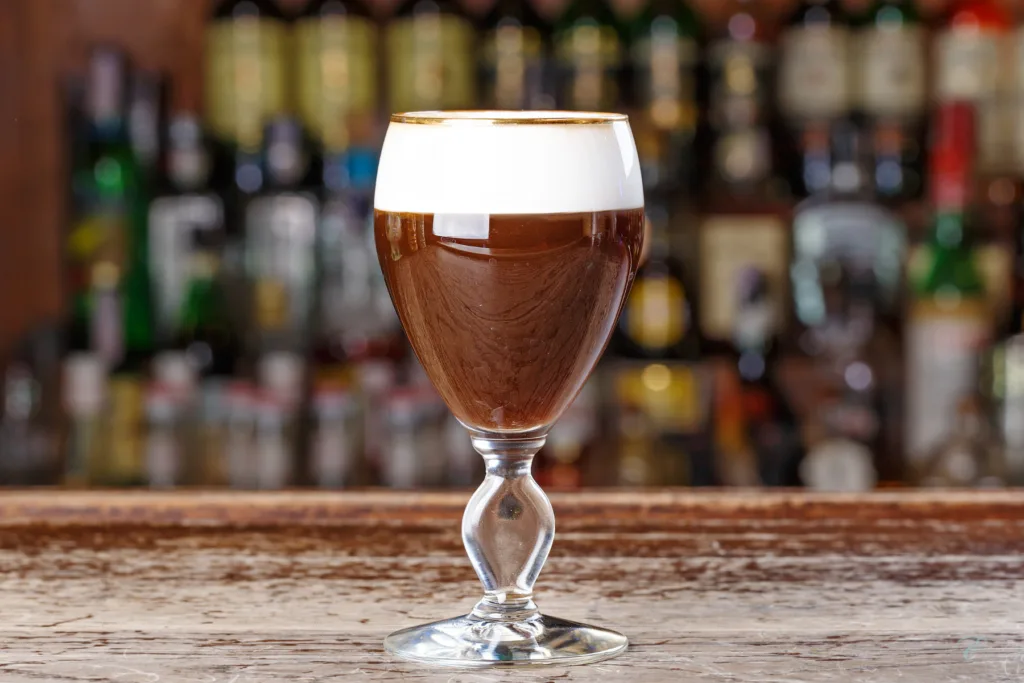
Visit a Coffeehouse
Let’s start out with a visit to a Viennese coffeehouse. Why is Vienna famous for coffee? In 1683, the Ottoman empire attacked the city of Vienna. After the Habsburg army defeated the Ottomans, they found bags of coffee beans left behind by the invaders. The Viennese paired the coffee beans with milk and sugar, and cafes dedicated to the beverage began popping up through the city. This tradition is now recognized by UNESCO as an Intangible Cultural Heritage.
Some must-visit coffee houses include Cafe Central, Cafe Sacher, Cafe Landtmann, Cafe Sperl, and Cafe Hawelka. Must-try drinks include the signature melange (similar to cappuccino), einspänner (black coffee with whipped cream), kapuziner (strong coffee with a dash of cream), faiker (strong coffee with a shot of rum), and the Maria Theresia (coffee with orange liqueur). Pair your beverage with an iconic pastry like sachertorte (chocolate cake with apricot jam), apfelstrudel (apple strudel with vanilla sauce), kaiserschmarrn (caramelized shredded pancakes), topfenstrudel (curd cheese strudel), or gugelhupf (classic Austrian Bundt cake).
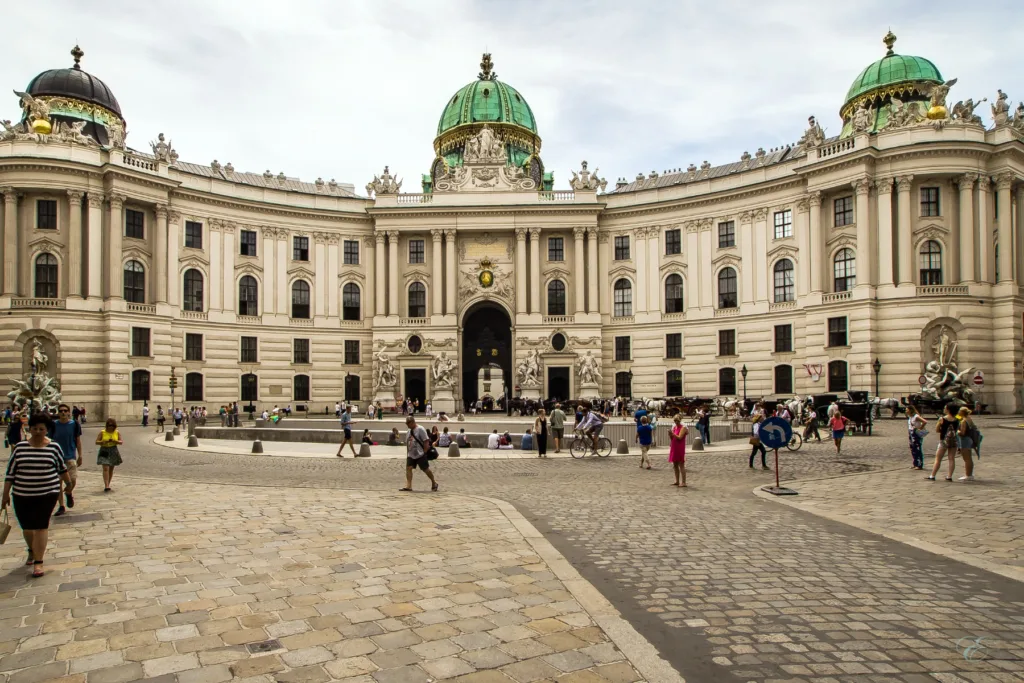
Tour Hofburg Palace
Spend the rest of your day touring Hofburg Palace. Located in the heart of the city, this was the winter palace of the Habsburg empire for more than 600 years. Today it serves as the office for the president of Austria. But you can still visit much of the palace. Tour the lavishly decorated Imperial Apartments where Emperor Franz Joseph and Empress Elisabeth (Sisi) lived.
The Sisi Museum provides a glimpse into the life of the enigmatic Empress Elisabeth (Sisi). Sisi became empress of Austria in 1854, but she struggled fitting in and pleasing her strict mother-in-law Archduchess Sophie. Renowned for her beauty and ankle-length hair, Sisi followed a strict diet and exercise regime. In her later years, she traveled extensively throughout Europe and was assassinated at the age of 60 by an Italian anarchist.
You can also enjoy a show or view the training routines of the Lipizzaner horses at the Spanish Riding School. Guided tours of the stables and arena are also available. And don’t miss the Imperial Treasury to see the crown jewels of Austria. For more opulence, also check out the Silver Collection.
Dinner & Bed!
Afterwards, you will be ready for dinner and bed. Just find a restaurant or cafe near your hotel. Here are some native foods to look for on the menu: wiener schnitzel (breaded and fried veal cutlet), tafelspitz (boiled beef in broth), gulasch (stew with beef and paprika), brettljause (charcuterie board), speckknödel (dumplings with bacon), käsespätzle (Austrian mac ‘n cheese), or leberkäse (meatloaf). Then get to bed – we have a busy day tomorrow!
Monday
As you learned yesterday, Vienna was the heart of the Habsburg Empire and has many regal and elegant historical landmarks to explore.

Tour Schönbrunn Palace
Our day starts by going just outside the city to tour Schönbrunn Palace. This site was the summer residence of the Hapsburg dynasty since the 16th century. During your visit, you can view the lavish Imperial Apartments and view historical artifacts of Empress Maria Theresa, Emperor Franz Joseph, and many more Hapsburgs.
Perhaps just as impressive as the palace are the gardens. These are proclaimed a World Heritage Site. Make sure to see the Neptune Fountain and to visit the Palm House greenhouse filled with exotic plants. Definitely make time to walk up to the Gloriette on top of the hill for panoramic views of Vienna.
Grab lunch near Schönbrunn Palace. There are restaurants and cafes on site and plenty of other places to try nearby. Then make your way back to city center.
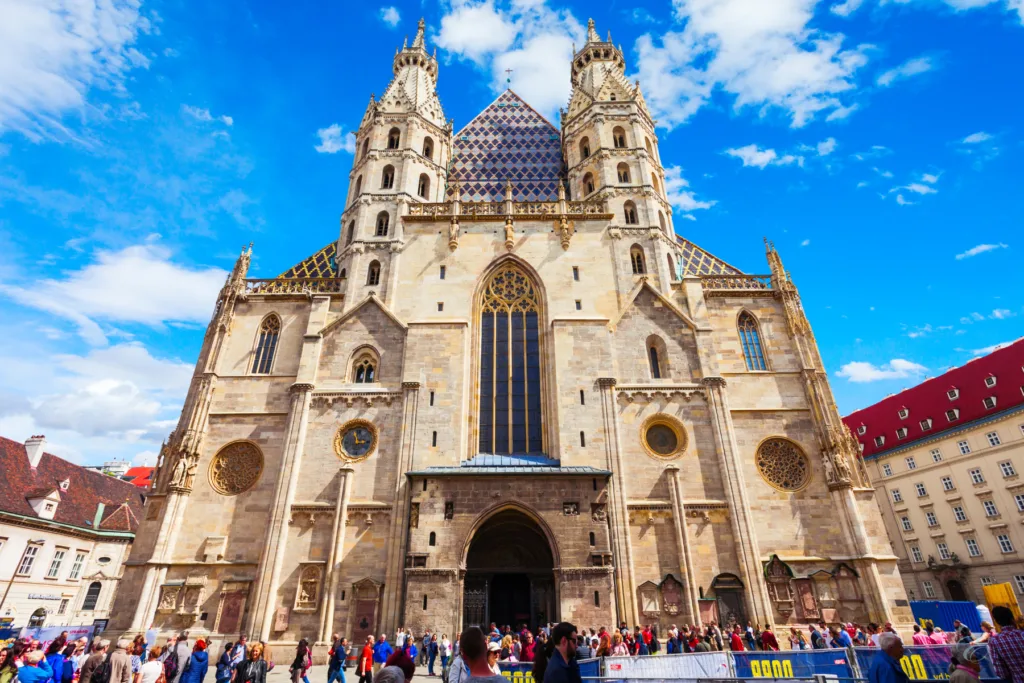
Other Historical Landmarks & Museums
This afternoon, you will visit several other historical landmarks in Vienna. Start at St. Stephen’s Cathedral. Dating from the 12th century, the Gothic cathedral features an ornate facade with intricate carvings. Take a tour of the cathedral to learn all about its history and works of art. For great views of the city, climb up 343 steps to the South Tower. You can also climb up the unfinished North Tower to see the Pummerin, the largest bell in Austria. Then descend into the Catacombs on a guided tour to learn about the people buried there and Hapsburg burial rituals. Best of all, opt for the All-Inclusive Pass that includes all of this plus the cathedral’s museum and Treasury of the Teutonic Order.
Another great place to visit is the Vienna State Opera. Take a 40 minute guided tour of the gorgeous building to see the details and other interesting facts.
End your day at MuseumsQuartier, a unique urban space filled with art, music, festivals, and places to lounge. Take one of the variety of guided tours available to learn more about the history and architecture of the space. Or visit one of the art museums in the complex such as the Leopold Museum, MUMOK (Museum of Modern Art), Kunstalle Wien, or ZOOM Kindermuseum. Wander through passages that connect the historical buildings to the more contemporary structures on-site. These passages serve as exhibition spaces for art installations, light projections, and digital exhibits. There are also lot of places to relax and get a meal or drink. If you are up for it, in the evening you can attend a dance performance at Tanzquartier Wien, a theater production at Dschungel Wien, or a concert or play at Halle E+G.
Tuesday
Today let’s take a break from Vienna and choose one of the wonderful day trip possibilities in Austria and beyond. One of the best things about Vienna’s location is that it is easy to hop over the border for a quick international adventure. But there are also some great options within Austria. Here are my favorite options for this itinerary.
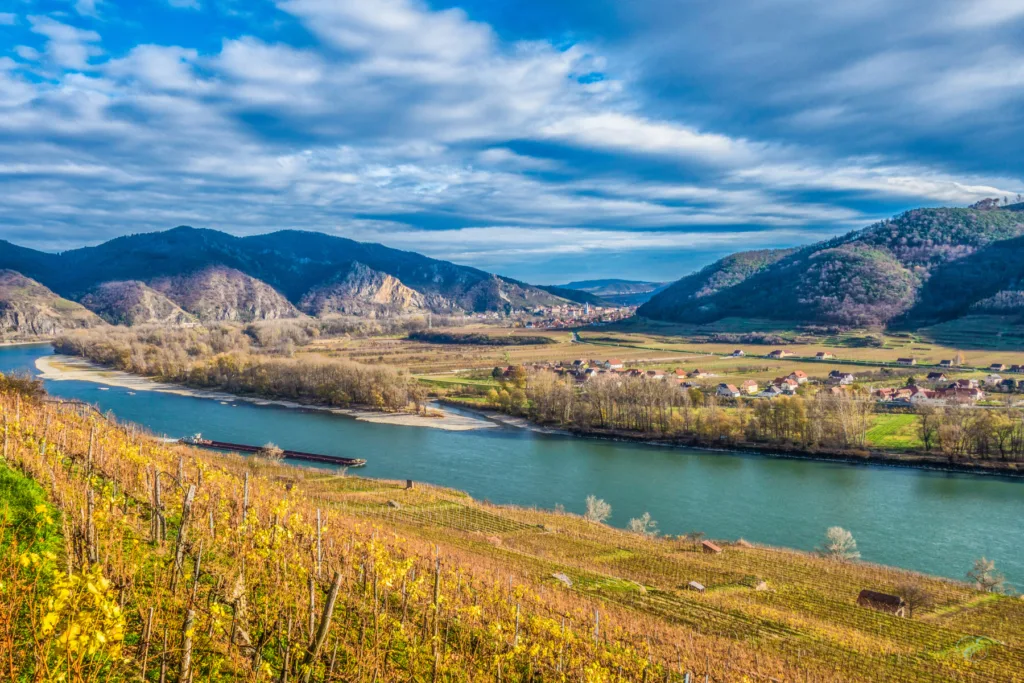
Option 1: Wachau Valley, Austria
Wachau Valley is a UNESCO-listed wine region nestled along the Danube River. The valley is best known for Grüner Veltliner and Riesling wines, so tasting a few should top your agenda. Start your visit in Melk and explore the breathtaking Melk Abbey. This monastery features stunning golden interiors, ceiling frescoes, and a terrace featuring panoramic views of the valley.
Take a Danube River sightseeing cruise or rent a bike to explore one of Europe’s most scenic routes between Melk and Krems. Stop in Dürnstein, the region’s most beautiful town. Climb up to see the Dürnstein Castle Ruins. This is where the English King Richard the Lionheart was imprisoned upon returning from the Crusades after he tore up an Austrian flag and refused to share his plunder with the king of Austria. You will see breathtaking views of the river and vineyards from the ruins.
Nearby you will find Domäne Wachau, one of the region’s best wineries. Take an estate tour and sample four of the vinyard’s wines.
It’s easy to get to the Wachau Valley by train from Vienna. It will take about an hour to get to either Melk or Krem to start your adventure. You can also drive there in about an hour. Another option is to book a tour from Vienna.

Option 2: Bratislava, Slovakia
Vienna is in a great location to base yourself for day trips to several different countries outside Austria. The closest one is Bratislava. Learn more about the history of the region at Bratislava Castle. This gorgeous building holds the Slovak National Museum of History which documents the history of society from the Middle Ages to present time. Marvel at a the massive Treasury containing gold and silver objects. And enjoy meandering in the Baroque gardens and the panoramic views of the city from the castle towers.
Wander around Bratislava’s Old Town where you can climb Michael’s Gate, the last remaining medieval gate in the city. Visit Main Square (Hlavné námestie) to see the Old Town Hall and Roland Fountain. You can also tour Primate’s Palace, a beautiful neoclassical palace featuring a Hall of Mirrors. As you wander through town, keep an eye out for the quirky bronze statues scattered around. Tuck into some traditional Slovak food for lunch at Bratislavskej Reštaurácii.
In the afternoon, head down to the river front to see the 15th century Gothic St. Martin’s Cathedral. Then take the pedestrian overpass over the Danube to the UFO Tower. An elevator will zip you up to the top in seconds where you can take in terrific views from the tower’s observation deck. If you still have some time to kill, cross back over the pedestrian overpass to explore the Eurovea Waterfront promenade full of shops, green space, and great views of the Danube. And take some time to visit the lovely Blue Church.
There’s a direct train that takes about an hour. Or you could enjoy a high-speed ferry ride that takes a little over an hour. Driving will also take about an hour, but you will need to purchase a Slovak highway vignette. You can also book a group tour.

Option 3: Budapest, Hungary
Known as the “Pearl of the Danube,” Budapest is the capital of Hungary. It’s really two different cities, Buda and Pest, separated by the Danube. Start your visit by taking the funicular up into the hills of Buda and visiting Buda Castle. You can take a tour of the royal palace and of the cave system under Castle Hill. Make sure to stop by the fairytale-like Fisherman’s Bastion for the best views of the city. And definitely take the time to go inside the Gothic Matthias Church featuring colorful tilework.
Walk down or take the funicular down to the Danube and walk over a bridge to the Pest side of the city, Here you can see the Holocaust memorial of Shoes on the Danube Bank. You can also visit the Hungarian Parliament Building on a guided tour. Climb to the dome of the beautiful neoclassical St. Stephen’s Basilica for more great views of the city. Make sure to allow plenty of time for a soak or spa service at Széchenyi Thermal Baths.
A direct train takes about 2.5 hours to get from Vienna to Budapest. If you want a cheaper option, you can take a FlixBus. This option will take 3-3.5 hours. Driving takes about 2.5 hours. You can also visit on a small group day trip.
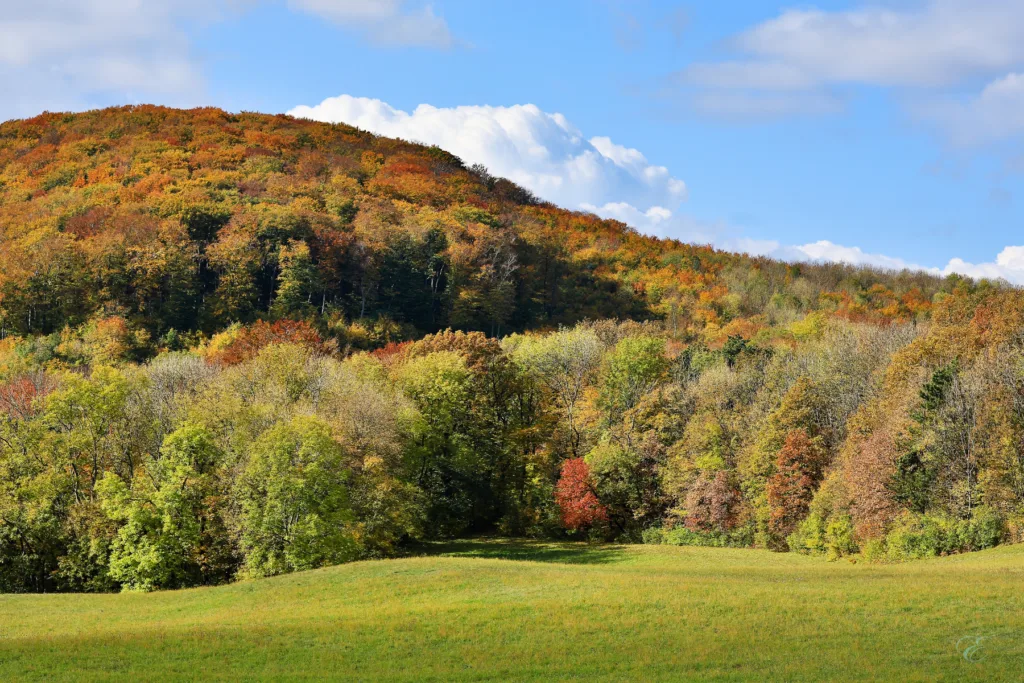
Option 4: Stay in Vienna!
If you prefer to explore more of Vienna, here are a few ideas.
Museums
If you wanted to visit one of the art museums in MuseumsQuartier but didn’t have time, now is your chance! Or opt to visit the Albertina Museum which features a world-class collection of masterpieces housed in a former imperial palace. Similarly, Belvedere Palace features an art collection and temporary exhibits in two beautiful Baroque buildings. Another not-to-be-missed museum is Kunsthistorisches Museum. This is one of the world’s greatest art museums filled with works by the great masters, Europe’s best Egyptian collection, and Habsburg treasures.
Outdoor Adventures
If you are ready for a little fresh air, you can visit Prater Park. This traditional city park also has an amusement park, beer gardens, a stadium, and many other attractions. Plan to have lunch at Nashmarkt, Vienna’s most famous open-air market.
If you want to venture a bit further afield, visit Vienna Woods (Wienerwald). There are many great scenic hiking/biking trails, and the woods are also home to historic castles and ruins. Tour the medieval Burg Liechtenstein castle and the Heiligenkreuz Abbey. Another historic site to visit is Mayerling where you can learn about the mysterious death of Crown Prince Rudolf in 1889. For animal encounters, visit the Lainzer Teirgarten (Wildlife Park). You can also tour Hermesvilla, Empress Sisi’s “Castle of Dreams.”
A final outdoor alternative is to visit the Danube River. Enjoy a sightseeing cruise to view Vienna’s skyline and modern architecture. Visit Copa Beach on Danube Island for swimming and sunbathing. Or ascend 827 feet in the Danube Tower (Donautrum). Then make your way down via the Turm Slide, Europe’s highest slide. Within just a few seconds, you could find yourself moving at the speed of more than 11 miles per hour!
Wednesday
Our week in Austria is almost halfway over! This morning we will transfer to Salzburg. A 2.5-3 hour direct train will get you there.

Once you arrive, take the 2 p.m. Sound of Music tour. This 4 hour tour takes you to all of the locations both inside and outside the city shown in the film. Even if you aren’t a huge fan of the movie, it’s a great way to get an overview of Salzburg and the surrounding area.
You visit various Sound of Music sites in Salzburg first, including Nonnberg Abbey (Maria’s convent, pass by). Lake Leopoldskron (site of the canoe scene), Frohnburg Palace (the von Trapp house, pass by), and the Hellbrunn Palace gazebo (of 16 going on 17 fame). Then the brightly painted bus takes you about an hour outside of town, stopping at Lake Wolfgang and Mount Unterberg (from the opening scenes of the movie) for a photo opportunity. Soon you arrive in the picturesque town of Mondsee. This is where the movie version of Maria and Baron Von Trapp got married (the real life version of the couple got married at the church at Nonnberg Abbey). Here you will have some free time to see the Collegiate Church of St. Michael, the site of the nuptials, look in the shops, and have a delicious slice of cake in one of the cafes. Then you board the bus to head back to Salzburg. Once back in the city, your tour ends with a guided tour of Mirabell Gardens, site of Maria and the children singing the Do-Re-Me song.
Thursday
Today we dive into the many great historical sites in Salzburg!

Hohensalzburg Fortress
Start at the 1,000 year old Hohensalzburg Fortress. Perched on a hill in the middle of the city, the fortress offers incredible panoramic views of Salzburg and the surrounding Alps. Inside the fortress, you can visit the lavish staterooms of the city’s Prince-Archbishops. And you will love the Magic Theater, an interactive multimedia experience combining light, sound, and digital protection to tell the story of the city’s history.
There are three museums on site. The Fortress Museum covers the history of the fortress, what life was like in the Middle Ages, and has displays of medieval weapons and armory. The Rainer Regiment Museum has exhibits on military history including uniforms from various eras. And the Puppet Museum showcases marionettes from the Salzburg puppet theater.
Take time to visit the 15th century St. George’s Chapel located inside the fortress. You should also see the Salzburg Bull. This circa 1500’s mechanical organ is one of the world’s oldest Gothic hornworks and is the oldest still played on a regular basis.
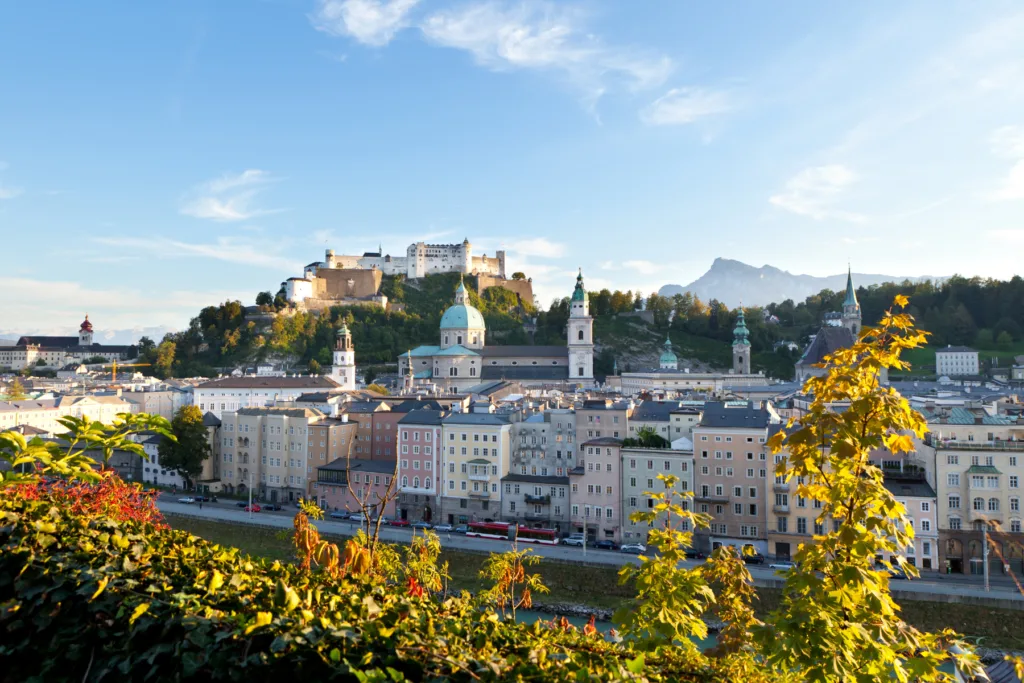
City Center Sites
After exploring the fortress, make your way to Salzburg’s Old Town. Have lunch and a brew at a traditional Austrian beer hall. Then spend the rest of the afternoon exploring the iconic 17th century Salzburg Cathedral, Salzburg Residenz (former palace of the prince-archbishops), and St. Peter’s Abbey, Cemetery & Catacombs.
Along the way, visit one of these sites’ many museums: Cathedral Museum, Museum of St. Peter’s Abbey, Residenz Gallery, and Panorama Museum.
This evening, attend a Mozart Dinner Concert. Or you can dine at St. Peter Stiftskulinarium, Europe’s oldest restaurant. Or just find a great cafe or restaurant near Residenzplatz, Salzburg’s largest square.
Friday
Today we embark on a day trip outside the city. There are many options to consider, both in Austria and Germany. Here are my favorite to choose from.
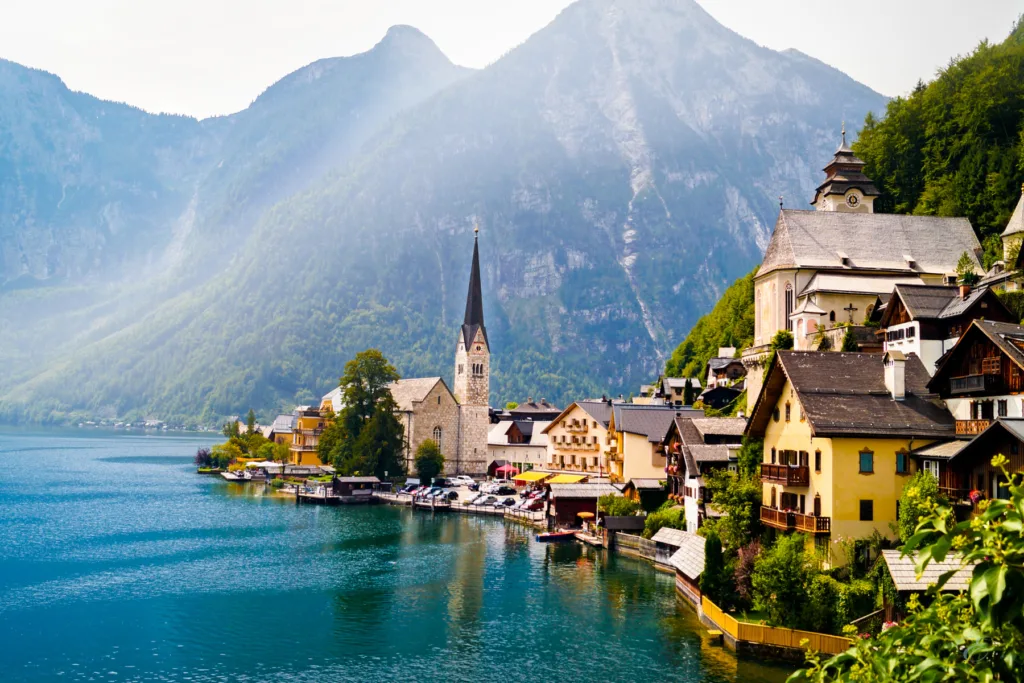
Option 1: Hallstatt
Hallstatt is a picture-perfect lakeside Alpine Village! Start your visit by exploring Hallstatt’s Old Town and Marktplatz where you will find pastel-colored houses and plenty of shops and restaurants. While in the city center, make sure to check out the Bone House (Hallstatt Ossuary) dating from the 12th century. This collection of 1,200 skulls are located in St. Michael’s Chapel. About half are painted with flowers, snakes, and crosses, and marked with death dates.
Spend the afternoon visiting the Hallstatt Salt Mine & Skyway. Known as the world’s oldest salt mine, you can discover the mine’s 7,000 year history with a three-hour visit. You will start at the Salzbergbahn funicular in Hallstatt. After a brisk ride up the mountain, you will take a bridge towards the lookout platform, Hallstate Skywalk. Then you will be guided on a 90 minute tour of the mine.
The best way to get to Hallstatt from Salzburg is by car which will take a bit more than an hour. You can get there by train, but it requires a transfer and takes about 2.5 hours. Then when you arrive, you will have to take a 5 minute ferry across the lake to reach the town center. If you don’t want to rent a car or waste time taking the train, your best bet it by going on a group tour.

Option 2: Berchtesgaden, Germany (Eagle’s Nest)
Berchtesgaden is best known as the location of Eagle’s Nest, Adolf Hitler’s mountain retreat. Today it houses a restaurant and a museum. When you visit, you will be bussed from the parking lot up four miles through five tunnels with a single hairpin turn. Then you can walk on a footpath or take an elevator up to the building. Once there, you will marvel at the panoramic views of the Alps and Berchtesgaden National Park. Take some time to learn about the history of Eagle’s Nest in the context of Nazi history at the Exhibition of the Institute for Contemporary History. Then enjoy a meal or snack from the onsite restaurant.
For more insight into the Third Reich, visit the Dokumentation Obersalzberg. Here you will find exhibits on Hitler, Eagle’s Nest, the Nazi Party, and the region’s role in World War II.
Another not-to-be-missed site is Königssee, an emerald green lake surrounded by mountains. Visit St. Bartholomä Church, which is only accessible by boat. And if you enjoy hiking and seeing wildlife, spend some time in Berchtesgaden National Park. This UNESCO Biosphere Reserve has numerous trails for you to view the spectacular scenery.
Take a guided tour of the Berchtesgaden Salt Mine where you will see underground lakes, salt crystals, and centuries-old mining tunnels. Ride on a miner’s train into the mountain, then whiz down miner’s slides to the lower levels of the mine. This is fun for kids and those of us who are kids at heart!
Berchtesgaden is only 30 minutes by car or public bus from Salzburg. If you just want to see Eagle’s Nest, you can take a group tour.

Option 3: Munich, Germany
It’s easy to visit the capital of Bavaria on a day trip from Salzburg! Located in southern Germany, Munich is a vibrant city full of incredible sites to see. Start with a visit to Marienplatz, a bustling square in the heart of the city. Here you will see the iconic Neues Rathaus, Munich’s town hall. Marvel at its ornate facade, and make sure to time your visit to see the Glockenspiel clock show at 11 a.m. and 12 p.m., as well as 5 p.m. from March to October.
Nearby you will find Viktualienmarkt, a food market with over 100 stalls selling produce, bread, spices, fish, meat, gifts, and souvenirs. Want to try some famous Bavarian beer? Viktualienmarkt is the location of Munich’s most central beer garden serving beer from all six Munich breweries. The square is also near all of the best shopping in Munich. Kaufingerstrasse is a car-free pedestrian area filled with department stores, fashion shops, perfumeries, and other specialty shops.
If you don’t spend all of your time shopping, you will enjoy exploring Englischer Garten, one of the largest urban parks in the world. Or if you love royalty and glamour, visit the Munich Residenz or Nymphenburg Palace. Both housed Baravian kings. Before you leave, stop by Hofbräuhaus München, Munich’s most famous beer hall.
You can catch a direct train to Munich and reach the city in under two hours. It’s about 1.5 hours by car. I
Saturday
Our week in Austria is almost over, so today we a few more must-see Salzburg sites to visit!
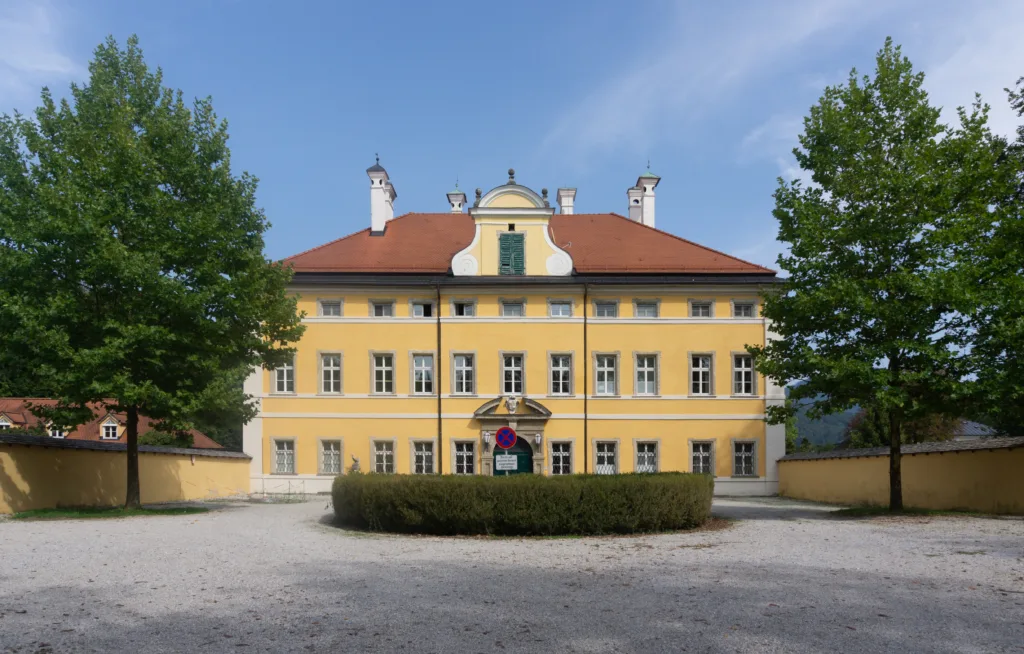
Hellbrunn Palace & Trick Fountains
Start your day at Hellbrunn Palace. Built in 1615 as a summer house for Salzburg’s Prince-Archbishops, this is known as a “pleasure palace.” The main highlight of the palace are the Trick Fountains. Created with hidden water jets, the fountains surprise and soak visitors. There are five immersive grottos wonderfully decorated towards their own theme and each containing sights or sounds operated by water.
The palace park features both landscaped gardens and untouched fields and forests. Here you will find the Stone Theater which is sometimes used for concerts and other performances. Another site in the park is Little Month Palace which today houses the Folklore Museum. Sound of Music fans will also love visiting the gazebo that inspired the scene where Liesl and Franz danced and sang the song “Sixteen Going on Seventeen.” If you love animals, take some time to visit the Salzburg Zoo featuring over 150 species of animals.

Mozart’s Birthplace & Residence
After lunch, visit the places where Mozart lived. He was born in Salzburg on January 27, 1756. He lived in the bright yellow building in Old Town until he was 17 years old. Today you can visit Mozart’s Birthplace to learn more about his early life.
Mozart’s Residence is where the composer lived from 1773-1781 when he left for Vienna. This more spacious home displays Mozart’s fortepiano and clavichord. There are also special exhibits, a display of Mozart’s writings, and the garden cottage where he composed parts of The Magic Flute.

The Great Outdoors
Spend the rest of your day exploring the great outdoors. Head to Kapuzinerberg, the scenic hill on the eastern side of Old Town. Rising 2,100 feet above the city, the hill offers incredible panoramic views. The most famous viewpoint is Franziskischlöss, a small castle at the very top of the hill which now is a hotel. After hiking up the hill, you can quench your thirst and tuck into hearty Austrian fare at The Tavern.
Or you can take a walk, bike, or take a boat cruise down the Salzach River. Cross over the Markartsteg Bridge connecting Old town to New Town to see hundreds of locks attached by lovers. You should also visit the Müllner Steg bridge for the best views of Old Town. While you are there, stop by the Augustiner Bräu beer garden, the largest in Austria. There are plenty of other riverside cafes along the river as well.
Sunday
Our week in Austria has come to an end. It’s time to head back to the airport and home to real life. Or better yet, the train station towards another European country!
Accommodations
You won’t spend much time in your hotel during your week in Austria. But you will want a comfortable place to stay. Good options in Vienna are MAXX by Steigenberger or Radisson Red Vienna. In Salzburg, try NH Collection Salzburg City or Radisson Blu Alstadt Hotel.
How to Get Around
You will find most sites in both Vienna and Salzburg to be within walking distance of your city center hotel. For sites that are a bit further away in Vienna, there’s a great public transportation system. There’s also a robust public transportation system in Salzburg. Or do as the locals do and ride a bike! And in both cities, you can use Uber or Bolt. Taxis are also available.
When will you spend your week in Austria?
Let us know below! Also follow us on Facebook, Instagram and Pinterest so you never miss a post!


